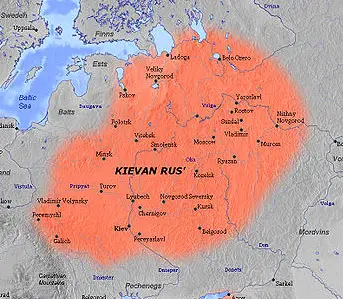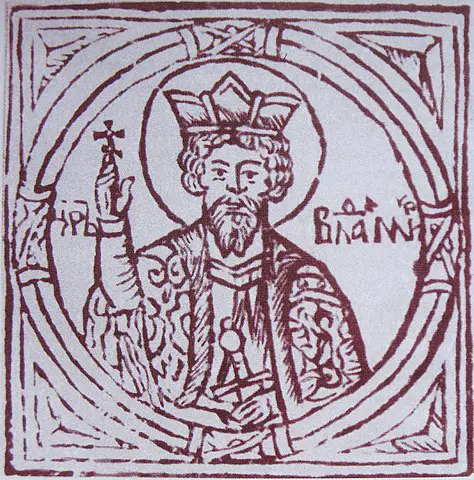Kievan Rus
Kievan Rus was the first organized state on Russian territory. At its height, Kievan Rus stretched from the Carpathian Mountains to the Volga River and from the Black sea to the Baltic. In area, it was the largest European state of its time. Modern states of Russia, Ukraine and Belarus all trace their cultural origins back to Kievan Rus.
Early History

The territory that would become Kievan Rus was inhabited by many different tribes speaking various Slavic languages.
In 830 CE, traders from Scandinavian regions headed south into the mouth of the Volga River. These traders were known as Rus, meaning in Norse, “men who row.” Russia gained its name from these early traders. They and other groups (called Varangians) continued south down the Volga and other river routes. Many began raiding rather than trading.
Rurik
One famous raider was the semi-legendary Norse chieftain, Rurik. He built a settlement near Novgorod. His descendants would go on and rule in Russian regions until 1598. They also married into many other European royal families.
Prince Oleg
After Rurik’s death, Prince Oleg took over in Novgorod, then expanded south. In 833, he moved the capital from Novgorod to Kiev, in what is now Ukraine. It was more central and easier to defend.
Chronicles depict Prince Oleg as a skilled warrior. With 80,000 men carried on 2000 longboats, he led a raid on Constantinople in 907. He did not conquer the city, but he forced the Byzantine Empire to pay him tribute to keep the peace. After several years, he also negotiated a trading treaty that benefitted both empires. Kiev grew to become an important center of trade between Scandinavia and Constantinople.
The Princes of Kieven Rus
Kievan Rus grew into a group of small states. Each one was governed by a prince paying tribute to the Grand Prince of Kiev. But unlike other areas of Europe where kingship passed from father to son, the title of Grand Prince did not. It passed on to the most senior prince. This allowed princes of any lineage to advance over time. The system was stable and prosperous for a while.

Trade
Princes of Kievan Rus grew rich from trade. In the winter, they traveled among various tribes and collected tribute: furs, money, slaves, honey. In spring, they put their goods on boats and sailed in convoys along rivers to Constantinople. They had to travel together to fend off attacks from various nomadic tribes.
Vladimir the Great
Vladimir the Great (980-1015) launched a golden age for Kievan Rus. He studied various religions and welcomed to his court representatives of Islam, Catholic Christianity, Judaism, Orthodox Christianity.

Legend has it that emissaries returned from a visit to Constantinople very impressed by the architecture of the Hagia Sophia, the great domed cathedral of the Orthodox Christian Church. They told Vladimir it inspired so much awe that they couldn’t tell if it was in heaven or on earth. After weighing the achievements and ideas of various religions, Prince Vladimir adopted Orthodox Christianity in 988 and thus set Slavic peoples on a new course.
Vladimir made the relations with the Byzantine Empire stronger by marrying the emperor’s daughter, Ann. After Ann died, he took a noble wife from the Holy Roman Empire to the West, She was most likely the daughter of the emperor, Otto the Great.
Influenced by trade with Byzantium, art and architecture flourished in Kievan Rus. Many of the churches built during this period can still be seen in the region today.
Writing
Before Kievan Rus, the Slavs had no written language. The Byzantine Empire sent monks who created an alphabet suitable for the Slavic languages. This eventually developed into the Cyrillic script used today. Many people in Kievan Rus learned how to read and write––unusual in Europe at the time. Some love letters and school notes written on birch bark have survived over the centuries.

The Fall of Kievan Rus
The unusual political structure of Kievan Rus led to more conflict as princes competed for control. Also, crusades to the South began destroying profitable trading routes. The sacking of Constantinople by Crusaders in 1204 dealt an especially hard blow.
When Mongols began attacking the borders, Kievan Rus armies engaged in battle after battle. Still, Kievan Rus princes squabbled. Soon, Mongol invaders conquered the princes one by one. The city of Kiev fell in 1240, ending Kievan Rus, the first Russian state.
For the next 200 years, Russian territory would be control by the Mongol Khanate.



